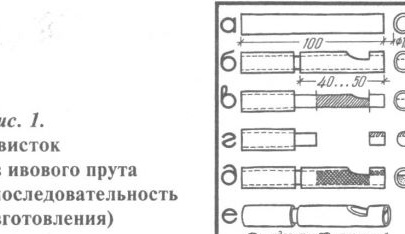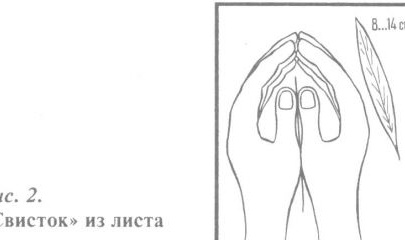
From time immemorial, in our countryside, children make whistles for themselves from willow, white and yellow acacia, various herbs, etc. And adults do not mind sometimes having fun and whistling, remembering their childhood.
I will give examples of the manufacture of several types of such whistles.
Whistle of willow. This whistle (Fig. 1) is made from a freshly cut willow rod 10 cm long and 10 mm in diameter. Such whistles come out best in April-May, when the trees begin a period of intense sap flow and the bark from the rod is very easily removed. So, choosing a suitable rod, cut off the workpiece from it (Fig. 1, a), at a distance of 4 ... 5 cm from either end, make a circular cut in the width of 2 ... 3 mm along the bark, that is, ring the workpiece to remove from this end of the bark. But so far, at a distance of 1 cm from the same end, a small depression is made with a knife (Fig. 1.6). With light strokes, the pickaxe or knife handles tap the area of the incised bark, after which, grasping this section of the bark with your fingers, slightly rotate the bark in one direction or the other, after which the bark is usually easily removed from the rod (Fig. 1, c). Of course, the bark should be removed with a tube. The resulting barked part is cut off at a distance of 2 ... 3 cm from the edge of the remaining cortex, after which a “key” is cut off from this separated part (Fig. 1d). It remains to split a small segment from the “key”, forming a channel for air intake (Fig. 1, e), put the removed bark on the barked part, insert the “key” into the tube from the cortex and the whistle is ready (Fig. 1, f). The whistle tone can be adjusted by moving the “tube” relative to the non-barked part.
A whistle from a straw. In May-June, try to make a whistle from a cereal plant (wheat, winter rye, etc.), which are in this phase in the tillering - heading phases. Taking a hand by the top of the stem, pull it up, taking out a green straw. Then a section 5 ... 6 cm long is cut or bit off from the bottom of the straw. The whistle is ready. Squeezing the straw in the lower part with two fingers, they begin to blow to the other end of the straw, getting a loud, voiced sound.
"Whistle" from the sheet. We tear off the oblong leaf of some cereal grass, put both hands in a “boat”, pinch the leaf between the thumbs and start blowing (Fig. 2).With the help of such a whistle, it is possible to imitate the nightingale trills, the cackling of a chicken or the crowing of a rooster.


